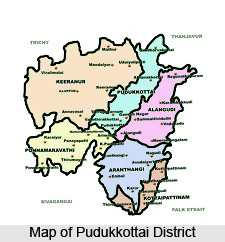 Pudukkottai district was carved out of the district of Tiruchirappalli and the district of Thanjavur in the month of January 1974. The district of Pudukkottai is spread over an area of four thousand six hundred and sixty three square kilometres and it possesses a coast line of about thirty nine kilometres. This district in the state of Tamil Nadu is located between seventy eight degree twenty five minutes and seventy nine degree fifteen minutes to the Eastern longitude and between nine degree fifty minutes and ten degree forty minutes to the Northern latitude. Pudukkottai district shares its borders with the district of Tiruchirappalli to the North and West, district of Shivaganga to the South, the Bay of Bengal to the East and the district of Thanjavur to the North-East.
Pudukkottai district was carved out of the district of Tiruchirappalli and the district of Thanjavur in the month of January 1974. The district of Pudukkottai is spread over an area of four thousand six hundred and sixty three square kilometres and it possesses a coast line of about thirty nine kilometres. This district in the state of Tamil Nadu is located between seventy eight degree twenty five minutes and seventy nine degree fifteen minutes to the Eastern longitude and between nine degree fifty minutes and ten degree forty minutes to the Northern latitude. Pudukkottai district shares its borders with the district of Tiruchirappalli to the North and West, district of Shivaganga to the South, the Bay of Bengal to the East and the district of Thanjavur to the North-East.
History of Pudukkottai District
Pudukkottai district`s history states its origin from the Tiruchirapalli District and Thanjavur District, when Pudukkottai was carved out from these two districts on the fourteenth of January 1974. Presently, the district of Pudukkottai is composed of two revenue divisions, called the Pudukkottai and Aranthangi and nine taluks, called the Kulathur, Illuppur, Gandarvakottai, Alangudi, Thirumayam, Aranthangi, Pudukkottai, Avudaiyrakoil and Manamelkudi. There are seven hundred and sixty five Revenue villages in this district. The total area of this district is four thousand six hundred and sixty three square kilometres. A majority of the villages of this district are of ancient foundation. Pudukkottai district was one of the homes of pre-historic man and the presence of a large number of burial sites found in the northern and western parts of the district attest this fact. The history of this district also deals with the rule of the Pandya Dynasty, the Chola Dynasty, etc over it.
Administration of Pudukkottai District
The district administration is having the collector as the head and the district collector is aided by a number of other subordinate officers in his general work of administration. The Revenue and Rural Development units of the district administration are controlled by the Collector through his Personal Assistants and Panchayat Development officers. The Pudukkottai district is having two revenue divisions and eleven taluks consisting of seven hundred and fifty seven revenue villages. The District Revenue Officer helps the Collector in all his responsibilities and he is also the authority for the land matters of the district. The district`s revenue collection is determined by the District Revenue Officer who also grants several licenses in the capacity of Additional District Magistrate.
Education in Pudukkottai District
The total population of the district of Pudukkottai in the Tamil Nadu state is 14, 59,601 and the total number of literates in the district is 9, 07,306. Education is well-developed in this district with four arts and science colleges, about seven colleges for professional education, about one thousand four hundred and thirty one schools for general education, about sixteen institutions for other professional education, etc.
Tourism in Pudukkottai District
The temples of Pudukkottai district are of great importance which attracts a large number of pilgrims through out the year. There are also various other places of religious importance for the Muslims, Jains, etc. Avudaiyarkoil is the most ornate temple in the district which is full of bursting barogue sculptures. It is the temple of Athmanatha. It is called Thirupperundurai in inscriptions and intimately associated with Siva saint Manickavasakar. The Rock-cut cave temple of Sri Gokarneswara-Brahadambal at Thirugokarnam is a Pandya art and belongs to ninth century A.D. It is the tutelary deity of Thondaiman rulers of Pudukkottai. The Pudukkottai Museum is located at Thirugokarnam having rare collections in Geology, Paintings, Zoology, Anthropology, Archaeology, Economics, Numismatics, Botany and Philately. The Fine Sculptures and bronzes of various periods are the attractive items of the Museum.
Another famous temple in this district is the temple of Lord Subramanya at Viralimalai on a hillock. It is also a peacock sanctuary, and is thirty kilometres from Trichy and forty kilometers from Pudukkottai. Kudumianmalai is situated twenty kilometres away from Pudukkottai. The presiding deity of the temple is Sikhagiriswarar. There are beautiful sculptures in the temple and the temple is noted for numerous inscriptions. Remarkable among them is the one relating to a musical treatise. There is a rock-cut cave temple with massive bas-relief dwarapalakas and with the architectural features of Hoysala style belonging to the 8th-9th century A.D. The Anna Agricultural Farm and Agriculture Research Institute are the other attractions of this place.
Some of the other major tourist attractions in the district of Pudukkottai are Kodumbalur, Thirumayam Fort, the ancient abodes of Jains at Chithannavasal, Pallivasal; an Islamic pilgrim centre, the oldest chapel at Avur, etc.






